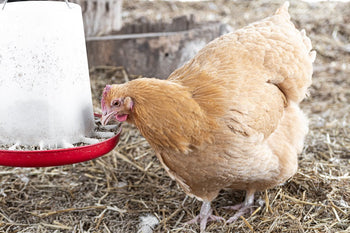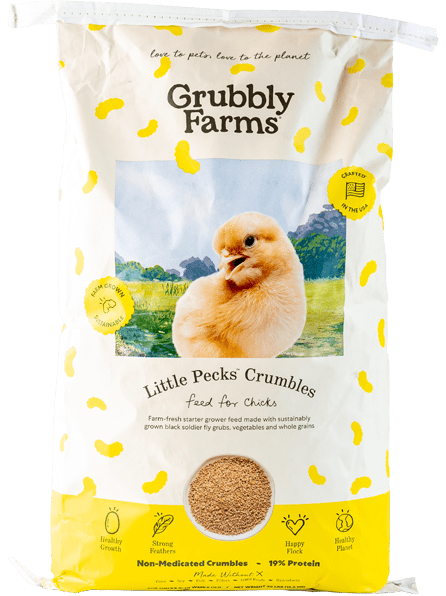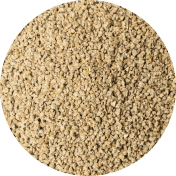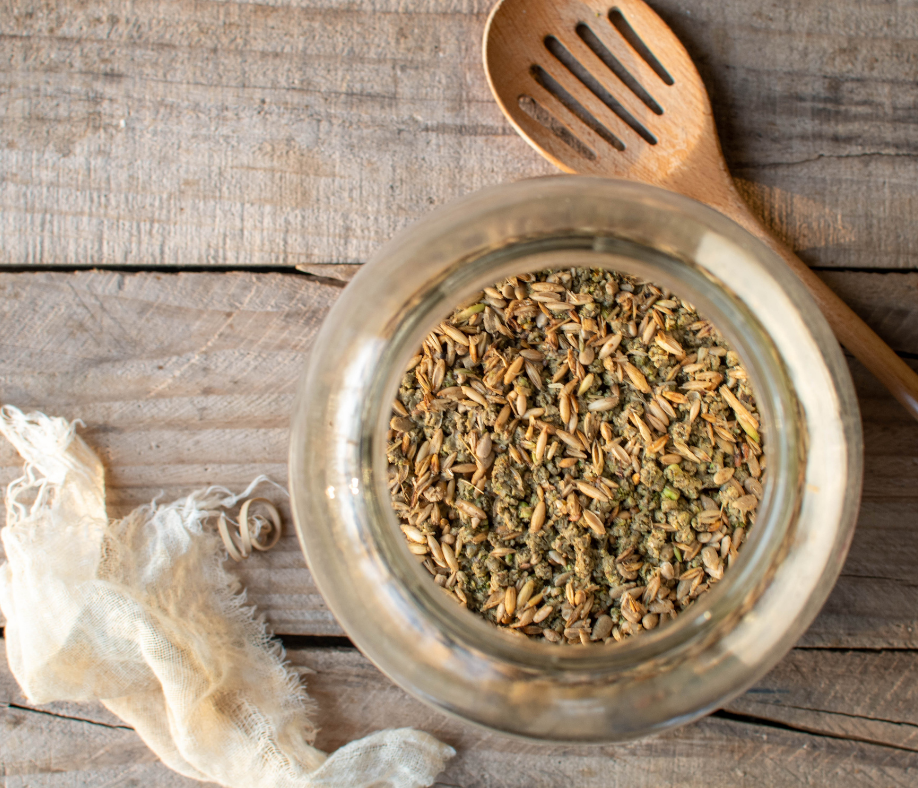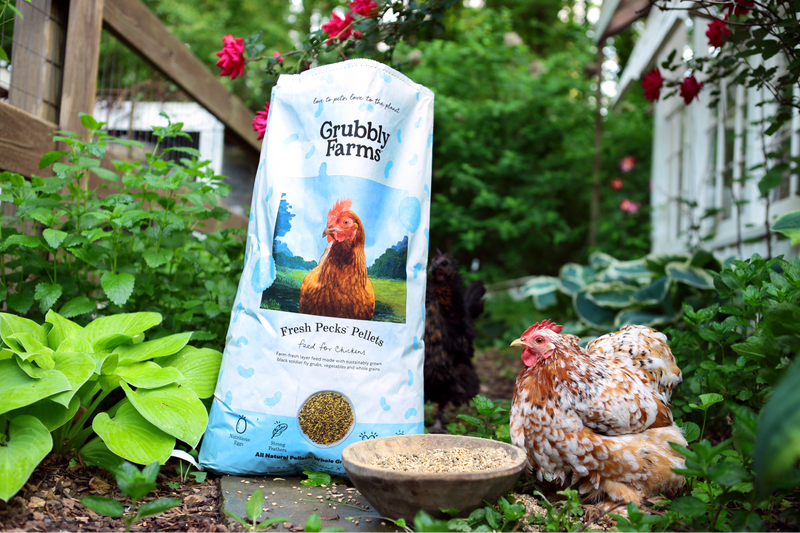Chickens need a nutritious and balanced diet in order to stay healthy and productive. While chickens can eat almost anything (they are omnivorous), they need specific nutrients in a balanced ratio daily to thrive. This guide to choosing the right chicken feed for your flock will help you navigate the various dietary needs of chickens to ensure your flock is receiving the nutrition they need to stay healthy and happy!
The 3 Main Factors to Consider When Selecting Chicken Feed
Chickens have different dietary needs based on their purpose, age, and even environmental factors. These various factors impact the nutrition that a chicken needs at any given time. Ensuring your chickens are getting the nutrition that they need to stay healthy means paying attention to the various dietary changes that need to occur depending on the following three factors:

Factor #1: Purpose of Keeping Chickens
Your purpose for raising chickens will impact what feed you choose to feed your flock. This ultimately boils down to what chicken breeds you choose as well. Chickens can be raised specifically for meat production, egg production, or breeding. Different breeds of chickens will have different dietary needs based on what purpose they were bred for.
Layer Feed- Chicken breeds bred for egg production need to be fed a complete layer feed. Layer feed is specifically formulated to meet the nutritional needs of a laying hen. Laying hens need the proper balance of nutritional elements to stay healthy and produce nutritious eggs. The main differences in layer feed compared to other chicken feed is the protein and calcium content.
Layer feed contains the proper protein content needed for egg production. If a laying hen receives too little or too much protein in her diet, it can cause her to stop laying or lead to protein-induced health complications. Calcium is an important part of a laying hen’s diet since she needs calcium to form strong eggshells. Layer feed should contain between 2.5%-3.5% calcium (1).
Meat Bird Feed- Chickens raised for meat production will need to be fed a different diet that supports proper growth and development. Chicken breeds developed for meat production mature at a much faster rate than chickens developed for egg laying. They also focus energy solely on developing muscle mass versus laying eggs. Meat bird feed will contain higher protein levels to help with efficient muscle development. It will also be high in energy to support faster growth.
Breeder Feed- Chickens kept for breeding purposes have slightly different dietary needs than a laying flock. Breeding chickens benefit from a high-protein diet to support reproductive health. A breeding flock feed is usually enhanced with additional vitamins and minerals to support embryo development.
All-Flock Feed- Lastly, another feed option that you may consider is an all-flock feed. An all-flock feed is formulated for a mixed flock of roosters and hens. Roosters do not need the additional calcium that is in layer feed. And if you are not focusing on breeding your flock, the additional protein in a breeder feed may not be necessary. An all-flock feed lacks the higher calcium levels of layer feed but still contains a balanced protein content to keep both roosters and hens healthy. Laying hens fed an all-flock feed will need access to supplemental calcium sources, like crushed eggshells, to meet their calcium needs.
Factor #2: Age and Life Stage
A chicken’s nutritional needs change as it grows and matures. When a chick is growing, it needs lots of protein to support muscle and bone development. As the chick matures into the ‘pre-teen’ life stage, it won’t need as much protein since most of its rapid growth stage is over. Then, once the young chicken reaches production age, it will need a diet that supports overall health and healthy reproduction. Growing, maturing, and reproducing all require slightly different nutritional needs.

Types of Chick Feed: Chick feed is offered in three major life stage types:
- Starter Feed- Chick starter feed contains higher protein levels than grower feed or layer feed and it does not contain the extra calcium levels that layer feed contains. A starter feed should contain between 20-22% protein to support proper growth in young chicks (1). Additional calcium is not needed in chick starter feed (even starter feed fed to chicks raised for egg production) since too much calcium at a young age can lead to kidney damage in young birds. Chick starter feed is generally fed to chicks from day 1 up until they reach 12 weeks of age. By 12 weeks of age, the chicks can be switched to a transitional grower feed. However, slow-maturing chicken breeds benefit from being kept on a starter feed up until 18-20 weeks of age at which point they can be switched to layer feed.
- Grower Feed- Grower feed is a transitional feed. Grower feed is often used for fast-maturing chicken breeds and chickens raised for meat. Protein is one of the most expensive components of chicken feed. Since chickens don’t need as much protein once they pass their peak growth stages, the protein levels in their diet can be decreased, which can cut back on feed expenses. Grower feed usually contains 14-16% protein (1), which is sufficient for the stage of life when chicks are not maturing as rapidly and have not reached production age. For chickens raised for meat production, grower feed is sometimes referred to as finisher feed.
- Starter Grower Feed– These feeds are formulated to suit the full chick to pullet life stage, minimizing the types of chick feed needed and reducing wasted feed as young birds transition between types. Our own Little Pecks is a starter grower feed that contains 19% protein and is the perfect balance for using as both a starter feed and a grower feed when raising chicks. The natural, insect-based protein source in the feed makes it ideal for feeding chicks naturally and sustainably.
Factor #3: Protein Percentage
The third factor to consider when choosing a feed for your flock is the protein percentages of the feed. A chicken’s diet is composed of several essential elements, including protein, fats, carbohydrates, vitamins, and minerals. Protein supplies amino acids, which are the building blocks for all body functions. Amino acids are necessary for growing, reproducing, maintaining a strong immune system, and are needed for all other body functions to work properly.
Chickens need 22 different amino acids in their diet in order to stay healthy (2). These amino acids can further be divided into essential and non-essential amino acids. Essential amino acids are ones that must be supplied by a chicken’s diet. Non-essential amino acids can be synthesized in a chicken’s body if proper levels of the essential amino acids are present.
A chicken’s protein needs change based on its age and what it is being raised for (meat, eggs, or breeding). Choosing a chicken feed that contains the proper protein content is essential for ensuring your flock is receiving the essential amino acids they need to stay healthy. Here are the common protein percentages needed by chickens of different ages and purposes:
- Chicks (0-12 weeks of age): 20-22% protein
- Growing Chicks (12-20 weeks of age): 14-16% protein
- Layers (20+ weeks of age): 16-18% protein
- Meat Birds (0-3 weeks of age): 20-24% protein
- Meat Birds (3+ weeks of age): 16-20% protein
- Non-Breeding Cocks: 10-12% protein
- Flock Maintenance: 16% protein
- Breeding: 18-20% protein
Additional Considerations

Crumbles vs Pellet Feed
As you are shopping for chicken feed, you may notice there several different forms of chicken feed, the most common being pellet chicken feed and crumble chicken feed. Layer feed, meat bird feed, grower feed, breeder feed, and all-flock feed can be bought in pellet form. Chick starter feed is sold as crumble feed and you can usually find layer feed in crumble form as well.
Pellet feed is for adult chickens. The pellets consist of ground-up feed ingredients that have been mixed together and processed into a pellet. Each pellet contains uniform nutritional value. This form of chicken feed prevents chickens from pecking out what feed ingredients they prefer to eat and leaving behind the finer, unpalatable ingredients.
Crumble feeds are commonly formulated for chicks but can also be geared towards adult birds. The crumble feed is essentially pelleted feed that has been broken down into crumbles. The smaller particle sizes make it easier for small beaks to eat.
Avoiding Fillers in Chicken Feed
Many chicken feeds contain filler ingredients. Filler ingredients are cheaply sourced ingredients that simply add energy to the diet. Two of the most common filler ingredients in chicken feed are corn and soy.
There are several issues with filler ingredients in chicken feed:
- Corn is a cheap energy source
- Soy is an incomplete protein source and harder for chickens to digest (2)
- Fillers are not as nutrient dense as wholesome ingredients
- Corn and soy are not sustainable ingredients
- Chickens need to eat more feed that contains filler ingredients to get the nutrition they need, resulting in greater expense for the flock owner.
Many filler ingredients are also GMO ingredients. GMO ingredients have been genetically modified and can contain harmful insecticides and herbicides. Chicken feed ingredients that are commonly GMO include corn, soybeans, alfalfa, canola, and cottonseed (2).
It is important that you choose a wholesome chicken feed that is free from fillers and contains non-GMO ingredients. A wholesome chicken feed should mimic a chicken’s natural diet and contain sustainably sourced ingredients. Chickens will consume less overall volume of a balanced, nutrient-dense feed since they are getting the nutrition they need from natural, rich feed ingredients.
The Importance of Grit
Grit is small particles of coarse rock and dirt that chickens consume to aid with digestion. Granite grit is commonly sold in feed stores as poultry grit. Chick grit is the same as poultry grit, it has just been broken into finer pieces that are easier for chicks to eat. Grit is necessary for helping a chicken’s gizzard break down tough food items such as whole grains, seeds, scratch, and fibrous foods.
Chickens who are fed only a pellet or crumble diet with no additional treats or snacks don’t need grit. The processed pellets or crumbles are soft enough to be digested without the aid of grit. However, if you give your flock any treats, snacks, or scratch grains, they will need a source of free-choice grit. Chickens allowed to forage or free-range will seek out natural grit from the environment as they forage.
To learn more about grit, check out The Role of Grit for Chickens.
Conclusion

Chickens need a complete, balanced diet that contains sustainable and natural ingredients. A complete feed should mimic a chicken’s natural diet and supply your chickens with the energy, protein, vitamins, and minerals they need daily. A chicken’s dietary needs also change as it grows, matures, and starts reproducing. When choosing chicken feed, make sure the feed is formulated for the age of your chickens and that it contains the proper protein levels. Assess your flock’s dietary needs regularly to ensure they are getting the food and nutrition they need to stay healthy and productive!
Sources:
- FEEDING CHICKENS FOR EGG PRODUCTION IN SMALL AND BACKYARD FLOCKS – Small and backyard poultry (extension.org)
- Damerow, Gail. The Chicken Health Handbook: A Complete Guide to Maximizing Flock Health & Dealing with Disease. Storey Publishing, 2015





